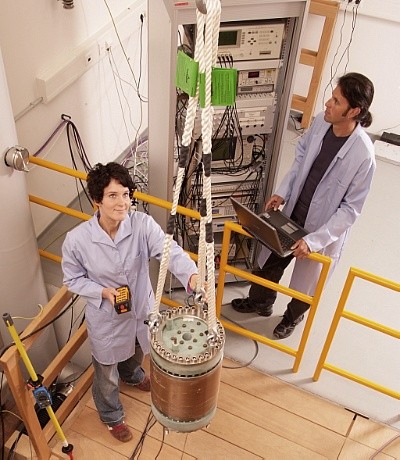Jun
29
Magnet Power Climbs Again
June 29, 2011 | Leave a Comment
This time the team at Helmholtz-Zentrum Dresden-Rossendorf set a new world record for magnetic fields with 91.4 teslas. Sergei Zherlitsyn and his colleagues at the High Magnetic Field Laboratory Dresden (HLD) developed and used an electromagnetic coil weighing about 200 kilograms in which electric current created the giant magnetic field – for a period of a few milliseconds. This lifts the record from the Los Alamos group, that’s likely worried more about the local forest fire this week, from 89 tesla. Note these records run fractions of a second, not steady state.
What makes this worth knowing is the magnet results drive materials research. For example, at Florida State the research from Los Alamos and HLD guide building experimental continuously running magnets.
Joachim Wosnitza, the HLD director explains, “With this record, we’re not really that interested in reaching top field values, but instead in using it for research in materials science,” even though the scientists are actually proud of being the first user lab worldwide to make such high magnetic fields available for research. The more powerful a magnetic field is, the more precisely the scientists can examine those substances which are used for innovative electronic components or for so-called superconductors which conduct electricity without any resistance.

New World Record Setting Electomagnet. Click the thumbnail photo on the press release page linked above for very large downloads of this photograph. Click image for the largest view served here.
When an electromagnet is running the field it makes also influences the electric current used inside the magnet because it tries to push the electric current out of the coil. The stronger the current flows, the more powerful these forces are. “At 25 teslas, the copper would be torn apart,” said Wosnitza.
The materials coming for electronics, superconductors and components are going to need tested. To examine as closely as possible the electric charge in the materials of tomorrow, researchers need higher magnetic fields with, for example, 90 or 100 teslas. HLD is there, barely.
Wosnitza calculates, “At 100 teslas, the Lorentz force inside the copper would generate a pressure which equals 40,000 times the air pressure at sea level.”
That force level would tear copper apart like an explosion. Which is why researchers use specific copper alloys, which can withstand ten thousand times the atmospheric pressure. Then they add a corset made from a special fiber that is typically used for bulletproof vests and which holds the alloy together from the outside.
For several weeks, the HLD technicians worked on the coil that set the world record. The technicians wound six of these special wires with corsets into a coil that has a hollow space of 16 millimeters at its center. This permits the generation of 50 teslas within this special coil when a brief but powerful electric pulse flashes through the copper – a process that is over after a mere 0.02 seconds.
The technicians then added a second coil consisting of twelve layers of copper wire around the first one. This wire, though, can only withstand 2,500 times atmospheric pressure. But protected by a plastic corset, a current pulse lasting only a fifth of a second suffices to create a 40 tesla magnetic field inside the coil. Together with the 50 teslas of the inner coil, this adds up to the world record of more than 90 teslas.
Covered by a steel jacket, this double coil has a height of 55 centimeters and a diameter of 32 centimeters. The size looks a lot like a fairly large water bucket. The new electromagnet will permit many future studies of new materials in the record setting magnetic field.
The Dresden High Magnetic Field Laboratory at Helmholtz-Zentrum Dresden-Rossendorf is attracting a flock of researchers from across Europe, Japan and America. The reservations are stacking up to analyze materials. Today there are five rooms equipped with similar coils and that can’t satisfy the crowds of researchers. HLD plans an additional six of these “pulse cells” will be built by 2015.
Magnetic-field research at the HLD is continuing to expand even after setting the world record.
It may not seem important to build the world’s strongest magnet, but having such powerful magnets for testing the materials used in the things we use makes engineering them at the beginning much more of a sure thing. Testing also show which paths of material development offer the most useful results. The products to come from power lines to tiny electronic devices will all come sooner, better, cheaper and more glitch free because the testing will sift to the best ideas earlier.
Keep those tesla results increasing; it means better and more efficient products for everyone.

